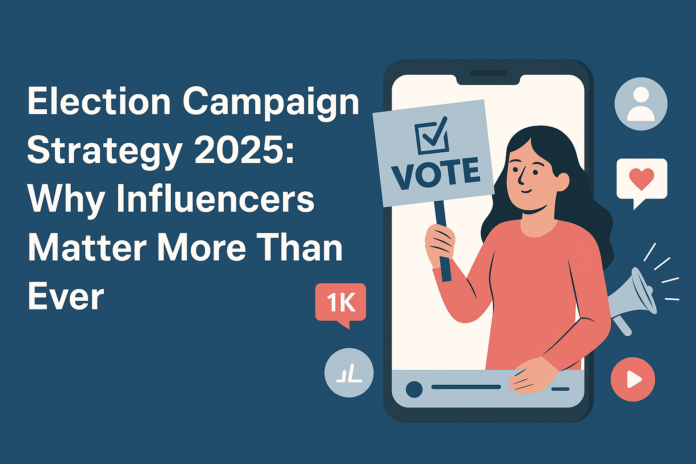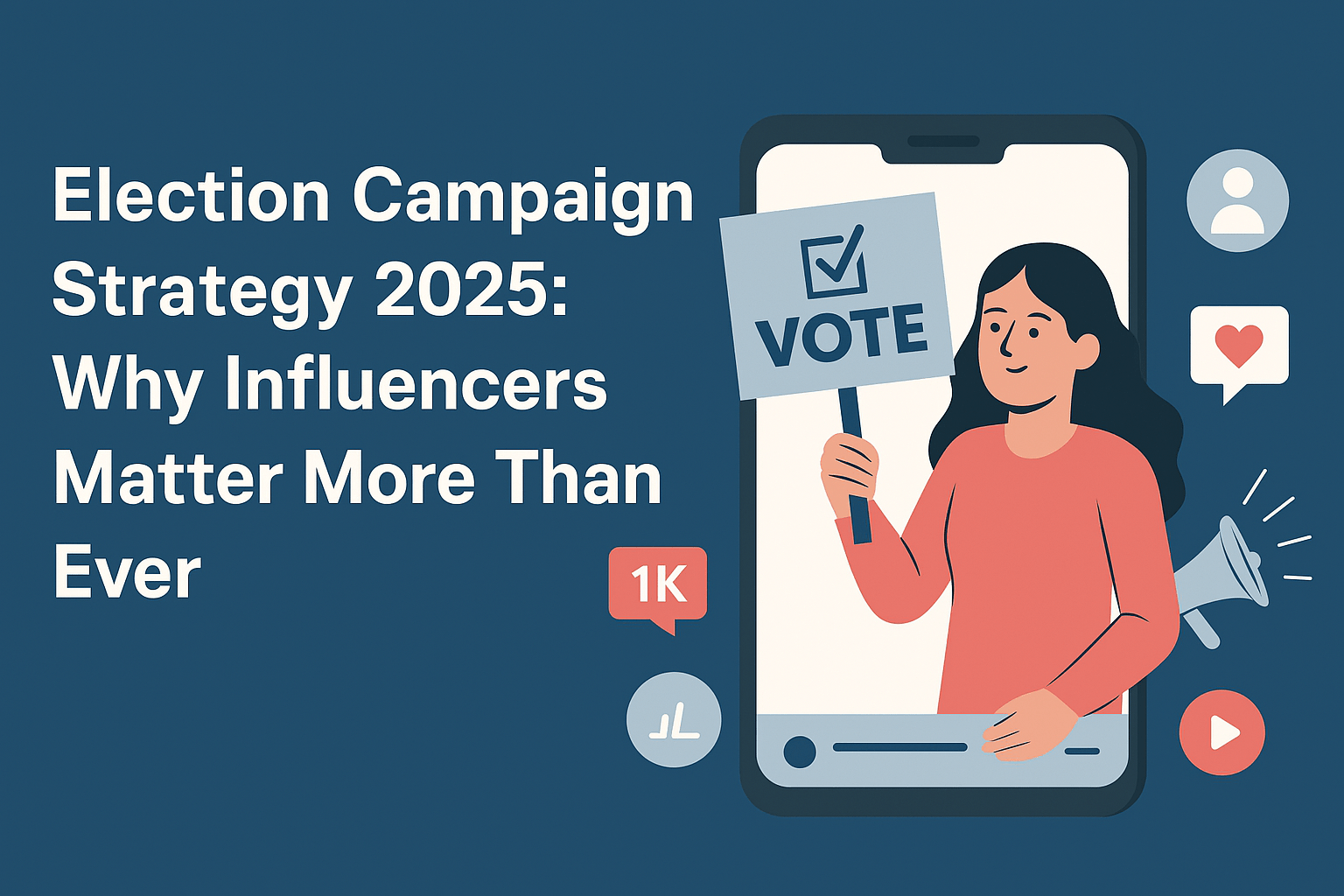
Election Campaign Strategy 2025: Why Influencers Matter More Than Ever

Introduction: The New Era of Political Communication
As the 2025 general elections approach, political campaigns are undergoing a digital transformation. Traditional media like television, newspapers, and radio are no longer the only sources shaping public opinion. Enter influencer marketing—a powerful tool that is redefining election strategies in the digital age.
From Instagram reels to YouTube collaborations, influencers are becoming essential players in modern-day political campaigns. This article dives deep into why influencers matter more than ever in election strategies, especially in 2025, and how political parties can harness their potential for massive impact.
Section 1: The Digital Shift in Political Campaigning
1.1 The Rise of Social Media in Politics
Over the last decade, social media for political campaigns has exploded. Platforms like Instagram, YouTube, Facebook, X (formerly Twitter), and even WhatsApp have become core battlegrounds where narratives are shaped and public opinion is swayed.
Fact: Over 65% of voters under 35 consume political content online daily.
Trend: Gen Z and Millennials trust content from influencers more than official political party handles.
1.2 Why Traditional Campaigning Alone Is Not Enough
While physical rallies and news debates still matter, they don’t provide the personal touch and emotional connection that social media influencers offer. Influencers already have the audience, the trust, and the engagement—three critical pillars for political success in 2025.
Section 2: What Makes Influencers So Powerful in 2025 Elections?
2.1 Trust Over Ads
Unlike political ads, influencers provide peer-to-peer endorsements. Their followers see them as relatable figures, making their content more influential than a billboard or a newspaper column.
2.2 Niche Reach with Maximum Impact
Influencers can cater to micro-audiences—students, rural youth, urban professionals, regional communities, women voters, and more. This hyper-targeted reach is what makes them invaluable in complex, diverse electorates like India.
2.3 Content That Connects
Whether it’s a 60-second reel explaining why voting matters or a detailed YouTube vlog interviewing a candidate, influencers can simplify political messaging and make it accessible, especially to first-time voters.
Section 3: How Influencers Are Shaping Election Campaigns
3.1 Educating Voters
Influencers are being tapped to raise awareness about:
Voter registration
Election dates
Polling booth processes
First-time voter tips
3.2 Endorsing Candidates and Parties
While some influencers stay neutral, others openly endorse a party or candidate. This can be done via:
Sponsored posts
Interviews
Live sessions
Reaction videos
3.3 Running Civic Campaigns
NGOs and even Election Commissions are working with influencers for non-partisan campaigns like:
#GoVote
#YouthForDemocracy
#MyVoteMyRight
These create viral social movements, especially on Instagram and YouTube.
Section 4: Key Strategies for a Successful Influencer-Driven Political Campaign
4.1 Identify the Right Influencers
Not every influencer fits every campaign. Political strategists should consider:
Audience demographics
Platform performance (Instagram, YouTube, etc.)
Engagement rate
Reputation and authenticity
💡 Tip: Micro-influencers with <100k followers often drive higher engagement than celebrity influencers.
4.2 Craft Authentic Messaging
Let influencers use their own voice. Over-scripted content feels fake and backfires. Authentic storytelling works better than polished PR statements.
4.3 Create Platform-Specific Campaigns
Each platform has its strengths:
Instagram: Short-form content, polls, stories, reels.
YouTube: Long-form discussions, behind-the-scenes videos.
Twitter/X: Real-time updates, threads, polls.
Facebook: Community building, group discussions.
WhatsApp: Targeted message forwarding in rural/urban groups.
4.4 Leverage Regional Language Influencers
India’s linguistic diversity is massive. Tamil, Bengali, Marathi, Telugu, Kannada, and Bhojpuri influencers can communicate better with local audiences than national-level content creators.
Section 5: Examples of Influencer-Based Political Campaigns
5.1 India (2019–2024)
Lok Sabha Elections 2019: Influencers partnered with Election Commission to increase youth turnout.
State Elections: Regional parties in Maharashtra, Punjab, and Tamil Nadu have run influencer-based awareness drives.
#PledgeToVote Campaign: Influencers across India created challenges encouraging voter turnout.
5.2 United States
Joe Biden’s 2020 campaign included TikTok collaborations, celebrity influencer shoutouts, and podcast interviews.
Alexandria Ocasio-Cortez (AOC) played Among Us live on Twitch, discussing policy with young voters.
5.3 Europe and Beyond
Countries like the UK, Germany, and Brazil have begun institutional collaborations between election commissions and influencer marketing agencies.
Section 6: SEO Best Practices for Political Influencer Campaigns
6.1 Top Keywords to Use in 2025
Election campaign strategy 2025
Political influencer marketing
Social media campaign for elections
Influencers in politics
Digital election strategy
Youth voter engagement India
Political branding through influencers
Voter awareness campaigns 2025
6.2 Optimize Content Across Platforms
Use SEO-friendly captions and hashtags.
Add transcripts for videos and closed captions for accessibility.
Use geo-targeted hashtags: #DelhiVotes2025, #KarnatakaElections2025
6.3 Leverage Video SEO
For YouTube:
Add “Election 2025” in titles and descriptions.
Include political keywords in tags.
Use chapters and timestamps to increase watch time.
Section 7: Challenges and Ethical Concerns
7.1 Fake News & Misinformation
Influencers may unintentionally share incorrect political facts. Fact-checking and editorial oversight are crucial.
7.2 Paid Propaganda
Unlabeled sponsored posts blur the line between opinion and advertisement. Influencers must disclose paid partnerships as per Election Commission and ASCI (Advertising Standards Council of India) guidelines.
7.3 Trolls, Hate Speech & Cancel Culture
Political content invites strong opinions. Campaigns must be prepared for backlash, comment moderation, and PR damage control.
7.4 Regulatory Hurdles
The Election Commission of India is likely to introduce stricter social media guidelines in 2025. Non-compliance could lead to bans, fines, or electoral disqualification.
Section 8: Future Trends in Political Influencer Marketing
8.1 Rise of AI and Virtual Influencers
AI-generated influencers will start promoting civic campaigns and sharing political content—offering scalable, 24/7 engagement.
8.2 Data-Driven Micro-Targeting
With analytics tools like Sprinklr, HubSpot, and Meta Ads Manager, campaigns can run hyper-local influencer promotions by constituency or issue.
8.3 Grassroots Content Creators as Political Leaders
We’ll see influencers becoming full-time political advocates or even candidates. The line between influencer and politician will blur.
Conclusion: The Influencer Edge in 2025 Elections
Influencers are not just content creators—they are agenda setters, opinion leaders, and change makers. In 2025, the most successful election campaigns will be those that adapt to this reality.
Political parties that invest in authentic storytelling, collaborate with trusted digital voices, and maintain transparency will capture not just eyeballs—but votes.




The shift toward influencer-driven campaigns makes a lot of sense given how fragmented traditional media has become. Curious how campaigns are balancing authenticity with political messaging though—seems like a delicate line to walk.
Comments are closed.